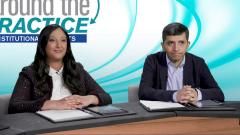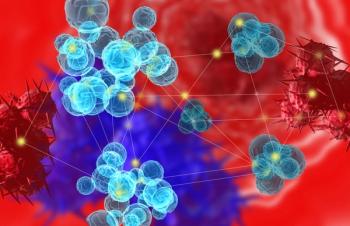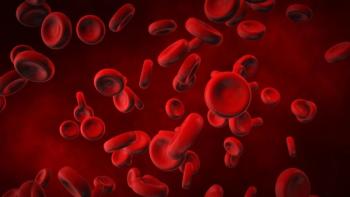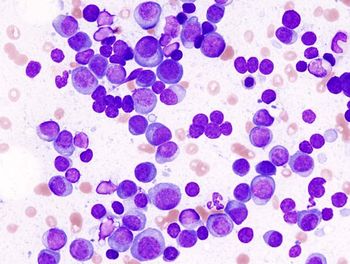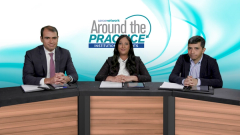
Bispecific Antibodies in Relapsed/Refractory MM: Future Perspectives
Closing out their discussion on the treatment paradigm of relapsed/refractory multiple myeloma, key opinion leaders highlight key takeaways and future directions in care.
Episodes in this series

Transcript:
Ajai Chari, MD, PhD: This other question about the role of bispecifics, I'm going to ask a question, see if anybody does anybody not want to see bispecifics in earlier lines of therapy? OK, see, we agreed, again, how often does that occur? OK, so I think the combination will be an interesting question, right? Because I think the addition of imids with neutropenia is going to be potentially challenging. But we're really excited about if you're getting, you know, if 60% is the new 20 to 30, what will that do in a less heavily treated patient? What will that do in a high risk, extramedullary disease patient and earlier lines of therapy, and keeping in mind, we're getting more and more CD 38 lead refractory, almost after first line therapy. So there's a lot of interest in using novel MLAs I think we're all excited about that.
Alfred L. Garfall, MD, MS: I mean provided that first line in the sense that, you know, we at some point, we stopped combining some older therapies just we're going to use the new ones right, we’ll use RVD. And I am really interested to see if down the pike we start to see some first line studies that instead of, you know, adding bispecifics to our standard backbone, first time therapies whether we can get one with justify specific and first line therapy. That's a trial that I think, you know, I don't know the answer to whether that how that trial will turn out. But it's potentially impactful to use these instead of some of our standard first line therapies.
Ajai Chari, MD, PhD: You bring up an interesting point, I'm hoping by first line, you mean consolidation and not induction. And the reason I'm bringing that up is I think something we haven't pulled out in today's discussion, which is important for the community doctor to know about is that heavy marrow burden can present with more complications, right. I'm curious to hear all of your thoughts, but I think I personally have seen even case should a patient, 2 or 3 patients with device specific to develop HLH, right, which is typically when these patients have heavy marrow burden. And then now you're trafficking all of these T cells to the marrow, you can get very high fevers, persistent cytopenias, and it behaves just like HLH from that we see more commonly, even though even still not common, but reported probably more with car T. I probably would like to do bulk a little bit personally with standard therapy, and then come in there to mop it up with T cell redirection rather than going right off the bat. But I want to hear your thoughts and also just your comments for the community folks on do share any concerns about the management of heavy marrow replacement in terms of fever, cytopenia management.
Sham Mailankody, MD: It's a heavy burden, whether newly diagnosed relapse refractory for all of these treatments, car T. And bispecifics, I do worry about patients who go in with lots of disease. And those are patients we monitor somewhat more closely, even more closely than other patients. And to your point of how we would develop these treatments in newly diagnosed setting. There are many ways combinations, replacements, consolidations. And that's not to mention all the different drugs and targets we talked about. It's going to keep us quite busy for many years, figuring out the exact combination and sequence to use these drugs.
Ajai Chari, MD, PhD: Great. Well, I really want to thank you guys for an interactive session. It's been super fun as myeloma always is because we're all myeloma nerds. And I want to just give each of you a chance to kind of give your takeaways I mean, again, I think I heard it said once by community Doctor, this is the new wave of the future, right? Yes, LL had a bispecific blinatumomab. But let's face it, this is going to be the first bispecific that's going to be widely used. It's the heralding of a new era. This may be the first but it's not the last we know bispecifics are coming for lymphoma, leukemia. This is a new era. What do you want to convey to the community folks where they don't have this experience that you all have of treating patients with bispecifics? And I'll start with just going from left to right, Al, you want to start?
Alfred L. Garfall, MD, MS: Yes, I just I guess we must wait for all the confirmatory studies. But my sense from the single agent activity of these agents and along with car T similar agents, that the sweetest therapies is going to add years to the survival of multiple myeloma patients. And that, to me, is my takeaway, that we're talking about a group of therapies that could be really, transformative in the same way that M is in PIs for transformative, you know, a decade or so ago.
Ajai Chari, MD, PhD: Great. Thank you, Krina.
Krina K. Patel, MD, MSc:Being able to give more access to patients out there, right. I think with the car Ts and the amazing responses we've seen, but not being able to get it to our patients has been really, hard. I will say I feel like a bipolar person, a lot of times that I'm excited. And other times I'm really depressed. But what I'm really excited about with the bispecifics is now having something that I can give my patients that really need stuff right now. And then to be able to do it in the community. That's, where all my patients are treated, right. And it's easy for us to sit up here and talk about myeloma. But we don't get to see all those patients and so to can be something that they can take out there is I think, pretty, pretty phenomenal.
Ajai Chari, MD, PhD: Great, thank you. And Sham?
Sham Mailankody, MD: I think, you know, when I started fellowship for oncology, which is not very long back, despite what my gray hair would tell, I had not heard a BCMA GPRC five d or FcRH5, which is only about 12, 13 years back. And the very first BCMA car T cell was when I was a fellow at the NIH, the first patients we did again in less than 10 years back in 2014. To think about where you know, not knowing any of these three targets to now having multiple drugs and treatments to target all of them, some of them already approved by the FDA, others that are coming along is a remarkable I mean transformation for relapsed refractory multiple myeloma certainly, and hopefully that same transformation will carry on for patients with newly diagnosed myeloma and earlier lines of treatment in the near future. So very exciting times.
Ajai Chari, MD, PhD: Right. I completely agree with all your sentiments. And if I could just fast forward to the next slide. I just want to highlight you know, we've learned so much from all the car Ts and bispecifics at our centers. The CRS is the main new learning curve for folks in the community. And if I must distill down what we've learned, this CRS, recognition and grading icons, recognition and grading is important during the REMS program for the all the T cell redirections. Both car Ts and bispecific now that have been approved all have REMS programs, highlighting the importance of training, training the floor team, you know, these patients are going to be typically in the hospital setting so that 14 needs to recognize fever. And it's not just a fever of an infection, perhaps increasing the vital sign frequency because in that patient could go from grade 1 to 2 just because you delayed checking the blood pressure or the oxygen. And that could lead to the difference between, you know, needing fluids vasopressors, etc. Then trading that frontline providers swhen the nurse picks up the fever the frontline provider who comes to assess the patient needs to be trained to recognize enter the orders promptly. I'll show you an example at Mount Sinai, New York. And we can happy to share these but you can create an order set in your EMR because then you don't have to worry about if you've never given Tosi what is the dose of ptosis right? It's a drop-down menu. Vitals can be you know need to potentially be done and monitored and assessment to the treatment. Laboratories like checking those inflammatory markers, coagulation, cytokines, having those therapeutics Tosi Dex Anna Kinross, talquetamab, timely administration, this is like febrile neutropenia if that temperature is recognized, how quickly is the intervention being given. And that means that it's a care team, it's the person who initially calls the person who assesses the person who puts into order, the pharmacy has to mix the drug, and then the drug has to be hung and given by the nurse. As physicians are probably the least important of that, right. And then notification, you know, once the drugs are given that the nurse is notified, and then you've heard today, the importance of interdisciplinary care, neurologists need to be trained about icans and mental status changes, neuro radiology for more severe, particularly with the car T but the ICUs may need to be aware infectious disease ERs. ERs, in particular, for patients gotten a T cell redirection, how do we alert them to that and the importance of contacting? And also all of our outpatient oncology, I would say that we've probably gotten more calls about T cell redirections in the last three years than we've gotten throughout our entire careers, in terms of overnight, because these things don't happen at convenient times, right. It's important to have all your systems in place. Whatever can make things easier for your system. This is going to be inter disciplinary. And probably in the short term, there'll be a lot of back and forth, maybe first step up doses being done in academia and then being sent out to the community but still really important for community Doc's to get trained and learn these drugs and takeover, because we can't be giving all of these agents in academic centers and the drugs are too important not to be given. Because there's so many patients that are being treated, you know, 80% of myeloma has been treated in the community. We're depending on the community to, you know, come up to speed. And I think the purpose of this program is really to help get us there as a field. I just again, want to thank our entire panel. It's been an outstanding discussion, and it's a great time for myeloma patients. Thank you for your attention. This has been extremely informative. Thank you to our panelists for this insightful discussion. And thank you to our audience for watching this cancer network around the practice program on bispecifics in myeloma, we hope you found this discussion to be useful and informative.
Transcript edited for clarity.
Newsletter
Stay up to date on recent advances in the multidisciplinary approach to cancer.


